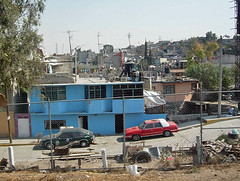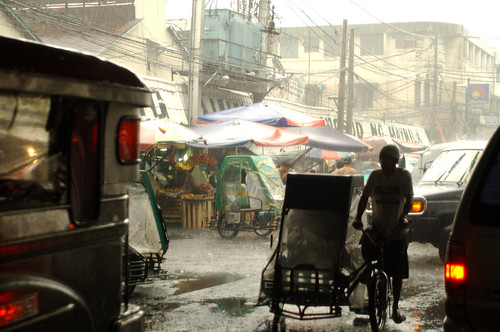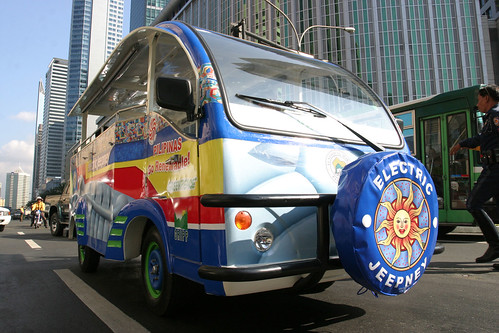links monday 073007

If you've been too busy to read through those very interesting links I've been putting in the Quick Links and Notable Posts on the Metro at the bottom of this page (both list are sourced from my del.icio.us links here, and here) , as well as the links to the Notable articles on top of my sidebar, I've decided to (*fingers crossed*) devote Mondays to a roundup of those links.
The articles are great reads and hopefully add to the lessons we can learn and ideas we can implement in our own metropolis.
Complete Streets
In USA Today, John Ritter reports on "Complete Streets" -the growing movement to design streets to accommodate all modes of transport -pedestrians, bikers, public transit and yes, private cars.
A growing number of states and local governments are rejecting a half-century of transportation practice and demanding that streets accommodate all types of travel, not just automobiles.Complete streets are "designed and operated to enable safe access for all users. Pedestrians, bicyclists, motorists and bus riders of all ages and abilities are able to safely move along and across a complete street."
I've discussed this topic extensively in my series on Rethinking our Streets.
See also the Complete Streets Coalition (US-based) for more ideas and links.
Paris and Public Transportation
In the New York Times, Serge Schmeman talks about what Paris is doing right:
"...to make it awful to get around by car and awfully easy to get around by public transportation or by bike."The Mayor of Paris, Bertrand Delanoë, a Socialist, has vowed to reduce car traffic in the city by 40 percent by 2020.
And Delanoë’s latest gambit in the anti-car war is the bicycle. Last week, the city started a program to rent out 10,000 bikes ( a program copied from cities such as Barcelona, Lyon, Lausanne and Geneva).He’s serious about it..two years ago the city laid down a granite divider between the bus-only lane and the cars, squeezing private cars from three lanes to two. Taxis and bicycles may use the bus lane.
At the same time, every bus stop was newly equipped with a screen that told you how long the wait was for the bus. During rush hour, when the cars stand still along Boul’ Mich, there’s nothing better than zooming past them in a bus.
Seems like human powered public transport is the way to go.
Transforming Mexico City
Meanwhile, NYT also reports that Mexico City Mayor Marcelo Ebrard is "trying to do what some might consider impossible: transform his megalopolis into a place that's more healthy, livable and even fun."
Since taking office in December, Mayor Marcelo Ebrard has imposed tougher traffic rules to make pedestrians safer, installed security cameras in high-crime neighborhoods and required city staffers to ride their bicycles to work once a month.
The city trucked in sand to build ''urban beaches'' at seven public pools, screened outdoor movies and inaugurated ''bicycle Sundays'' when thousands of cyclists, skaters and pedestrians take over the main avenues. Ebrard even invited former Vice President Al Gore to lecture city residents about climate change this week.
...
The mayor's goal is transforming the city into Latin America's latest model of urban renewal. The big idea behind these relatively inexpensive measures is that by encouraging happiness, rather than solely economic growth, he just might change residents' image of their city -- and themselves.
''For us, it's important to continue promoting healthy living, and that means taking back public spaces to create a safe, better city,'' Ebrard explains.
Not sure we can try the "Urban Beaches" (an idea they borrowed from the French) until we get the Pasig to an acceptable level of clean, but I'm certainly all for requiring public officials to take bikes (or public transit) to work.
The big picture though is that this is Mexico City we're talking about! If they can try it, why can't we?
Chinese cities want to speed up urbanization
Lastly, the Economist reports on the race to urbanize China. They highlight the case of Chongqing in western china and its race to make the "vast municipality (the area is as big as Scotland) an oasis of modernity in China's backward west (and its goal:) by 2020 the municipality must be 70% 'urbanised'."
The municipality's official population is more than 30m, which if it were a single city would make it one of the largest in the world. To achieve the 2020 target, country-dwellers must move into urban areas at a rate of more than 500,000 a year.Chongqing is a "microcosm of China's struggle to move millions from rural to urban areas." For all the travails of the rapid pace of urbanization (pollution, congestion, slums) China is determined to move its vast population into its cities for very rational economic reasons. They seem to understand that the growth of their economy is directly related to the growth of their cities.
A concept that somehow we haven't yet embraced. (Take a look at this gapminder chart of how urbanization is related to per capita income.)











